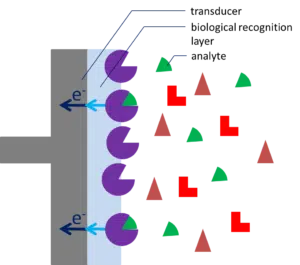Detection of Glucose with a Self-Made Biosensor 2/5 – What is a Biosensor?
This chapter is part of the series ‘Detection of glucose with a self-made biosensor based on glucose oxidase’. This section provides a basic introduction to biosensors. Later chapters elaborate on the basic principles of biosensors, their production, and how they can be used to detect glucose.
What is a Biosensor?
A biosensor uses a biological recognition element to convert a chemical signal into an electrical one. This very general concept is illustrated in Figure 1.

This conversion can be achieved in many different ways. Biological recognition elements can be enzymes or parts of the immune system. An enzyme is a biological catalyst. It speeds up reactions or makes them possible under given conditions; additionally, enzymes are very selective for certain reactions and only convert a specific substance or group of substances. The immune system of a complex organism like a mammal produces antibodies as a reaction to biological material from outside the body. Antibodies bind to this biological material specifically. The transducer element of a biosensor converts the reaction at the recognition element into an electrical signal. A very common method is using an electrode as a transducer. A free diffusing redox mediator is able to transport electrons from a redox enzyme to the electrode, thus forming the transducer together with the electrode.
Commercial biosensors
Although the free diffusing mediator in combination with the free diffusing enzyme works on small scales, they are not suitable for a commercialized version of a biosensor. The mediator and enzyme will be washed away and the sensor can only be used once and only in small defined volumes.
A better system is an immobilized biological recognition element. If a mediator is necessary, it should also be immobilized. The immobilization of a biological recognition element needs to be performed in a way that the enzyme, antibody, etc. keeps its activity. If the protein loses its structure due to the immobilization or if the way of the substrate from the bulk to the enzyme is blocked, the sensor will not work. Depending on the sensing system the movement of the mediator, products of the enzymatic reactions as well as the counter ions, has to be considered during a biosensor design as well.
See also Chapter Biosensor.
